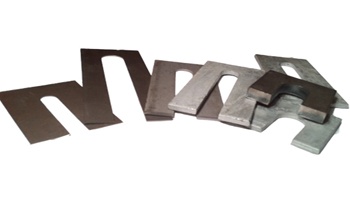
Whether Slotted Shims or Solid Shim Plates, common selections for shim material include Plastic, Carbon and Stainless Steel. Each has a specific benefit and when used properly, can provide adequate service for the entirety of the structure’s life.
Plastic Shims
The phrase “plastic shim” is a bit deceiving. The Steel Supply Company’s plastic shims are either, High Density Polyethylene (HDPE), High Impact Polystyrene (HIPS) or Korolath Plastic. Each consists of a rugged material with high compressive strength. For reference, our website shows a chart of the most recent Plastic Shim Compression Tests.
Click for Compression Test and Recycle Content
Both Solid and Slotted Plastic Shims have cross-over uses in all construction trades. They provide excellent durability, high compressive strength and when compared to steel shims, low cost. Like all plastic shims, one downside to HDPE, HIPS or Korolath Shims, is that they are compromised when exposed to continual UV Rays. While it can take years for the decay to make itself evident, this should be considered whenever shims are being used in an application that will be exposed to the sun and its elements.
Carbon Steel Shims
Plain Carbon Steel – The most common choice for shims that will exist in interior applications and not be exposed to weather. Typical A-36 or Multigrade Carbon Steel will have a compressive strength of approximately 22,000 psi. Also note that the compressive strength is measured to the point of “Permanent Deflection” i.e., it has deformed, or in the case of a shim, flattened out and still has not broken.
Hot Dip Galvanized Carbon Steel – Any application that involves exterior exposure or continual moisture will call for Hot Dip Galvanized Shims. Lintels or Relieving Angles, even though they don’t have direct exposure to the elements, are almost always specified in HDG due to the continual flow of air, humidity and moisture they are subjected to.
Mill Galvanized Carbon Steel – Occasionally called on for certain plans, but should not be considered in most cases. If a Slotted Shim is punched or cut from Mill Galvanized Steel, the edges are not galvanized. When installed, the edges are the only part of the shim that is exposed, so the Mill Galvanized surface provides protection only where it is least needed.
Stainless Steel Shims
Stainless Steel Shims usually get specified in situations where their environment will be extremely corrosive or shim failure will create a hazard, either in injury to people or property.
Examples of these situations include:
- Corrosive environments like salt water or areas with high content of vehicle exhaust.
- Interior applications, such as manufacturing or food processing, where the product being produced emits corrosive gases.
- Railway and overhead crane runways, where level tracks are imperative to smooth and safe operation.
Ultimately, the purpose of a slotted shim or solid plate shim is to take up space. At installation, almost any material will serve the purpose. The point of selecting the right material for the application is:
- To assure it will serve its purpose for at least the intended lifespan of the structure.
- To control costs by not over specifying the material required.
To learn more about shims manufactured by The Steel Supply Company, click the button below.





